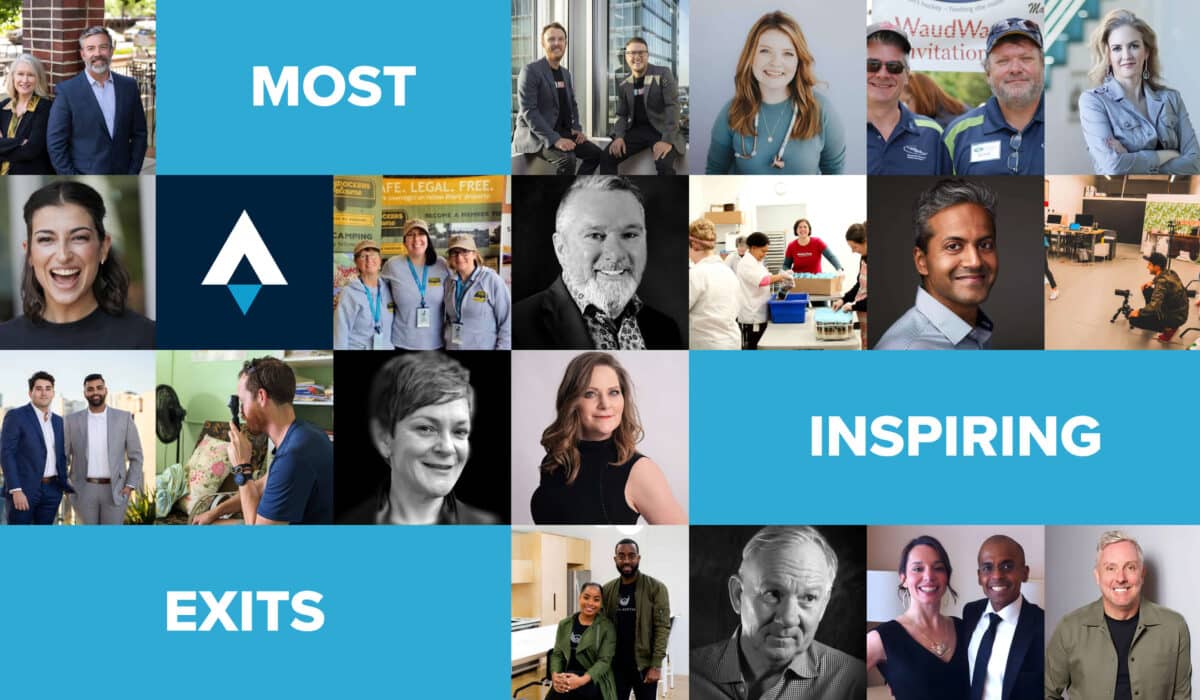They didn’t have venture capital backing or Silicon Valley connections.
No accelerator programs or celebrity investors.
Yet these founders all built remarkable businesses from scratch, relied on revenue to grow, and then sold for millions.
Meet the nurse practitioner who needed money for dental work, the burned-out business owner who lost her savings in a divorce, the college student who was sent home due to COVID and the mom who dreamed of starting a bakery.
Each story reveals the grit, creativity, and strategic thinking it takes to build something valuable.
And each acquisition is inspiring in its own way.
How we selected these 17 inspiring entrepreneurs
We’ve written more than 275+ stories about business owners who’ve sold, and each one has helped us and our readers learn about acquisitions.
But there’s something special about the founders featured in this story. Something about each of these stories stuck with our reporters, so much so that we wanted to find a way to spotlight them again.
The companies in this list all shared these common traits:
- Sold since 2021
- Deal size of $100k – $50M
- Bootstrapped
Beyond that, we looked for some “umph” factor that inspired us — because while inspiration can be hard to measure, we all know it when we feel it.
So here are our picks for Most Inspiring Exits.
Let’s celebrate how they built and sold bootstrapped businesses, following no one’s playbook but their own.
1. Sharon Gillenwater was refreshingly transparent after she and her co-founder sold their SaaS

📸 Snapshot:
- Boardroom Insiders (SaaS)
- Founded in 2008; sold in 2022
- Price: $25 million
Why we’re inspired: As a tech consultant, Sharon Gillenwater noticed a common problem: salespeople didn’t know how to connect with senior executive customers.
So in 2008, she launched Boardroom Insiders, a database of vetted executive profiles to help sellers build better relationships and close bigger deals. Two years later, she brought on co-founder and president Lee Demby.
Although she considered raising capital, Gillenwater walked out of her first meeting with venture capitalists feeling like they didn’t prioritize customer experience, so she bootstrapped the business with her consulting income. In 2022, the co-founders sold for $25 million.
Gillenwater has been refreshingly transparent about her experience — and even her take-home pay. She now mentors other founders through her Founder Power Hour. She’s proof you don’t need Silicon Valley money to build and sell something big.
Keep reading: How she scaled a database to $5M ARR, sold for $25M and split the proceeds
2. Sinkinson brothers transformed college safety — and turned down a $20M offer

📸 Snapshot:
- AppArmor (SaaS)
- Founded in 2011; sold in 2022
- Price: $32 million
Why we’re inspired: Brothers Chris and David Sinkinson started AppArmor while David was a student at Queen’s University in Ontario. He learned that 30% of the campus’ emergency blue light boxes were broken and, in 2011, pitched a solution: an app.
Over the next decade, the brothers built and iterated the product, facing critics along the way. “Ignore those people,” David said. “Don’t pursue validation in your peers. Pursue validation in the market instead.”
In 2021, with AppArmor on major college campuses, an interested buyer offered the brothers $20 million Canadian. They turned it down due to “a lot of strings attached.” But a year later, the same interested party returned with a counteroffer: $40 million Canadian — all cash, no complicated terms.
Now, through their podcast and book “Startup Different,” they help other founders succeed on their own terms.
Keep reading: These brothers turned down a $20 million offer for their campus safety app — then sold for twice as much
3. Sarah Michelle Boes turned a side hustle into a lifelong legacy
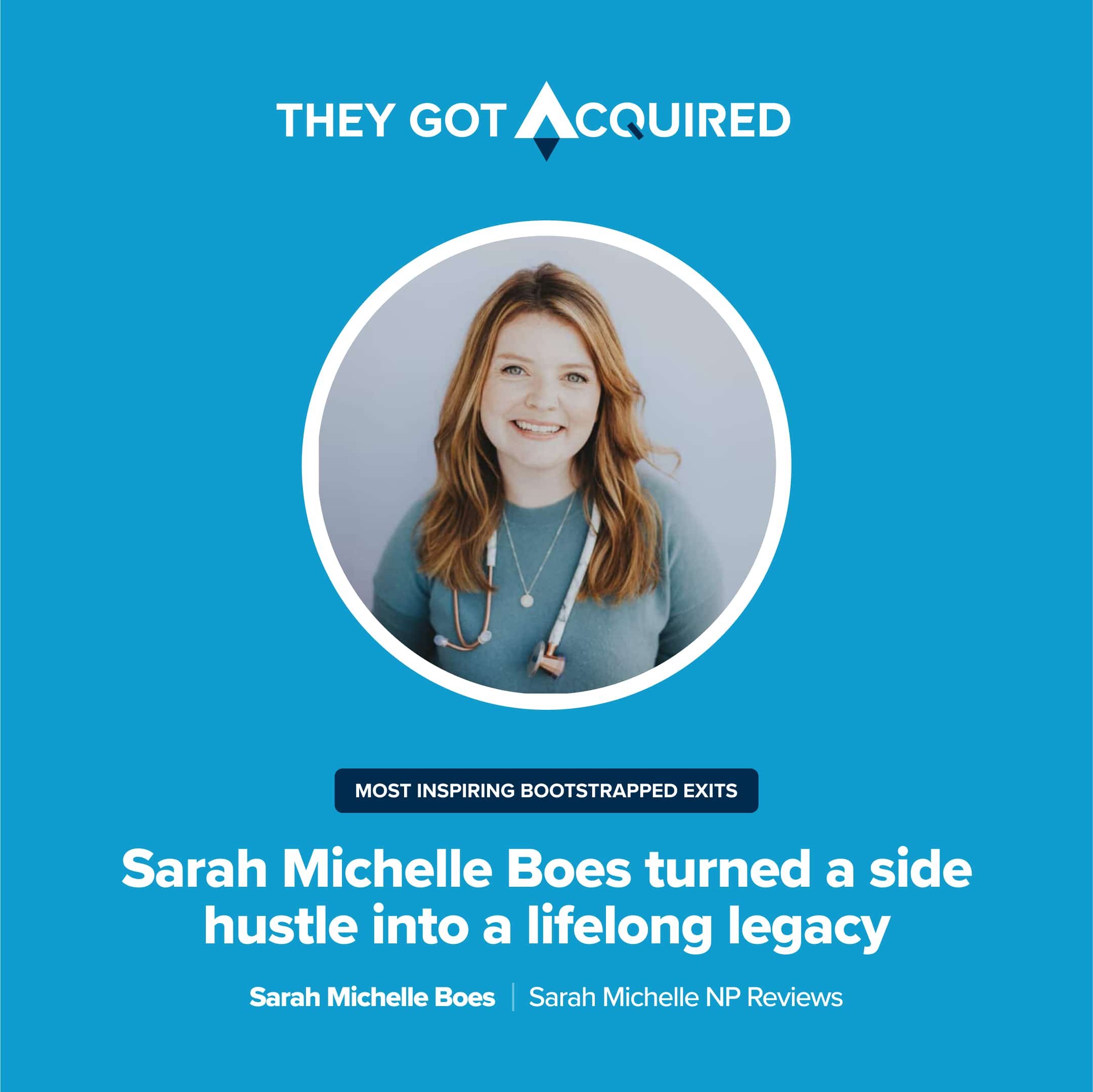
📸 Snapshot:
- Sarah Michelle NP Reviews (content)
- Founded in 2020; sold in 2022
- Price: 8 figures
Why we’re inspired: Kentucky-based Sarah Michelle Boes needed a $7,000 dental implant. Looking to make extra money, the nurse practitioner, who had just passed her NP exams, recorded a three-hour Zoom course to help other students.
Within seven months, Boes earned $1 million in revenue. In just two years, she’d helped more than 40,000 students pass.
Despite being told her business suffered “key woman syndrome” and would be “nearly impossible” to sell, Boes decided to test the waters.
An interested buyer made an offer, but it wasn’t her “magic selling number,” so Boes turned it down. Several months later, they returned with an 8-figure offer. Boes navigated the sale without an advisor or broker, leaning on her network and resources.
After the sale, her newborn daughter was treated for a life-threatening congenital heart defect. In gratitude, Boes and her husband donated a legacy gift of $15 million to the hospital where she received treatment.
Keep reading: She recorded a 3-hour course to help nurses pass their NP exams. Within 7 months, she’d made $1M in revenue
4. F. Charles Waud sold 35 years after launch in notoriously slow industry

📸 Snapshot:
- WaudWare (SaaS)
- Founded in 1989; sold in 2022
- Price: 10x EBITDA
Why we’re inspired: It often took a year for F. Charles Waud to close deals with new clients in the produce industry. One client, he recalled, took 10 years to go from initial call to sale. But Waud quickly learned the importance of patience.
“I’ve seen a ton of tech companies come into our industry, make a bunch of noise about being the latest and the greatest, and then leave or go out of business,” he said.
Waud ran WaudWare, which helped produce companies with inventory management and accounting, for decades before selling. He received an all-cash offer for 10x EBITDA and 1.5x revenue. He’d never sold a company before, but he decided to take a DIY approach, leaning on his extensive network of business owners.
For Waud, exercising patience — through building his business and selling it — paid off.
Keep reading: How this founder took a DIY approach to selling and landed 10x EBITDA
5. Caitlin Pyle helped thousands start WFH businesses while facing personal struggles
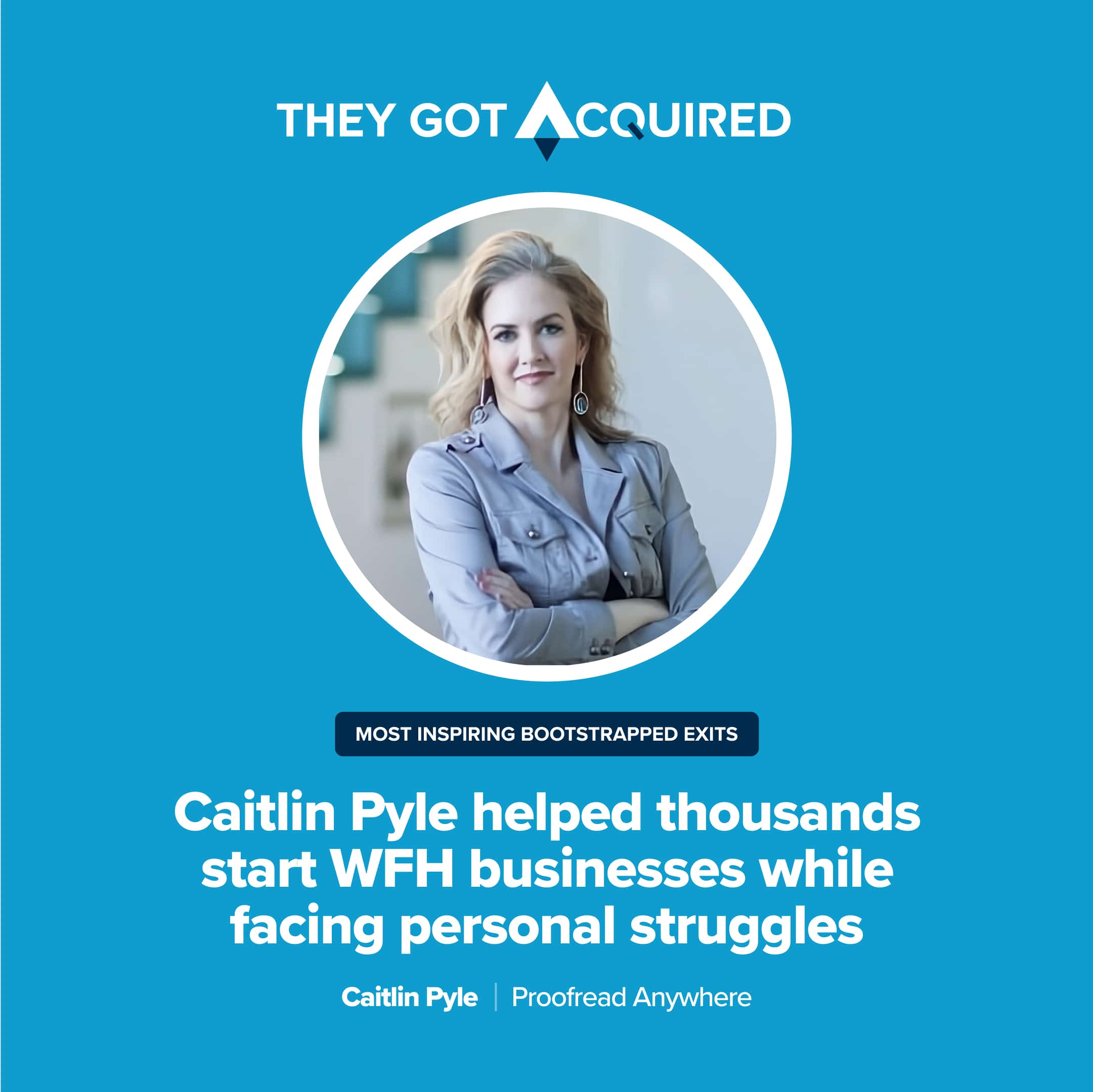
📸 Snapshot:
- Proofread Anywhere (content)
- Founded in 2014; sold in 2022
- Price: About $4.5 million
Why we’re inspired: For Caitlin Pyle, Proofread Anywhere started as a weekend project, but the business quickly grew. By 2022, the blog evolved into a go-to resource for more than 15,000 people who started their own remote proofreading businesses.
But it wasn’t all smooth sailing. Pyle experienced severe burnout in 2019, lost most of her joint savings in a divorce and faced several health challenges.
In 2020, she hired a CEO to take the reins, and they worked to separate her personal brand from the day-to-day. In 2022, Proofread Anywhere sold for nearly $4.5 million.
Now, she helps others overcome self-doubt as a life transformation coach.
Keep reading: She hired a CEO to strengthen her online training business, then sold for $4.5 million
6. Codner family business, serving an overlooked market, went global
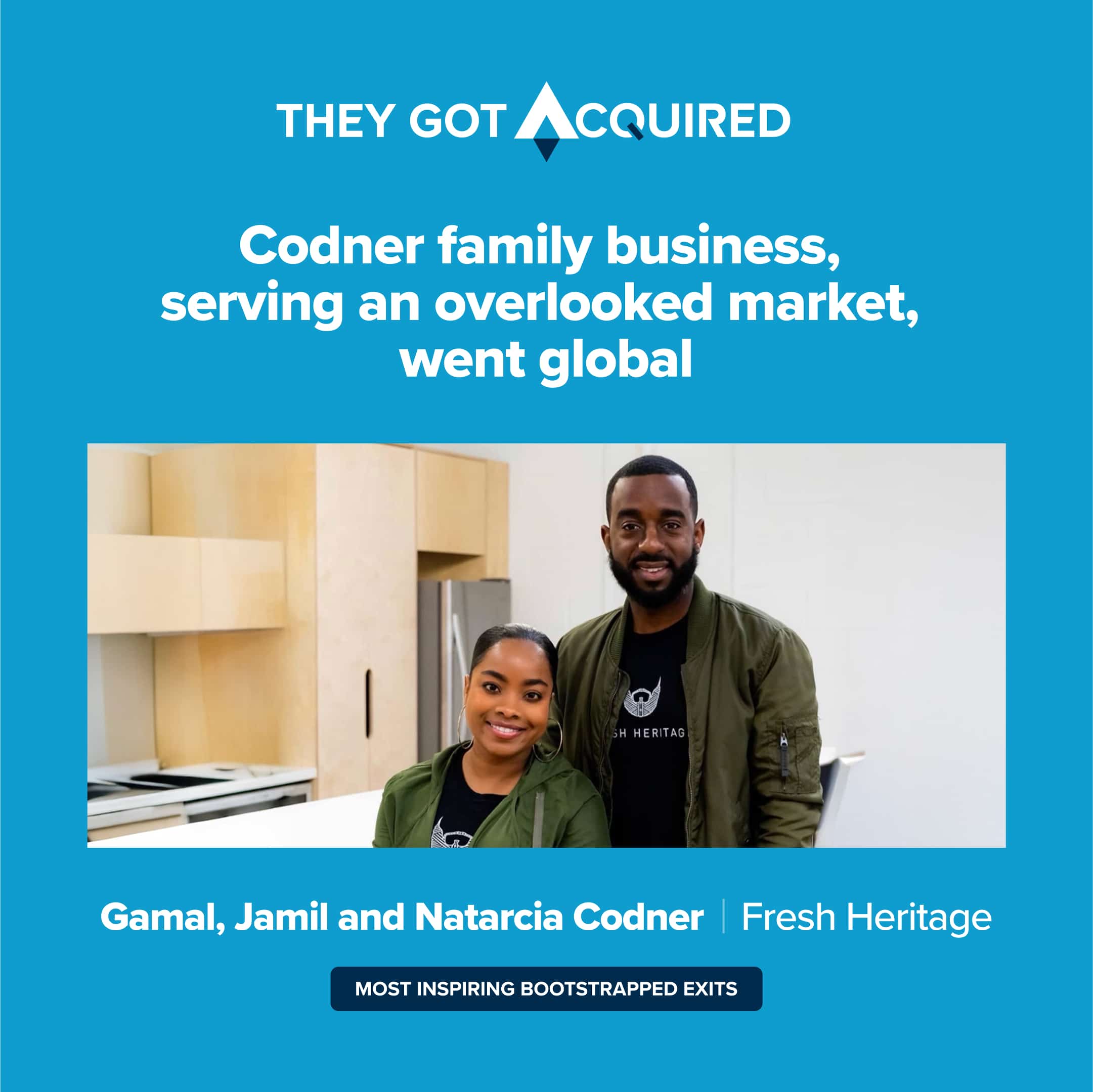
📸 Snapshot:
- Fresh Heritage (e-commerce)
- Founded in 2017; sold in 2021
- Price: Not disclosed
Why we’re inspired: Husband-and-wife team Gamal Codner and Natarcia Codner, along with Gamal’s brother, Jamil Codner, started Fresh Heritage after a trip to Northern Africa where they found natural ingredients in men’s personal care products.
Identifying a gap in the market for products catered to Black men growing beards, they launched Fresh Heritage. Within 90 days of launch in 2017, they hit $90,000 in revenue.
Wanting to scale globally, they found a buyer, which planned to take Fresh Heritage abroad. Now, the Codners help other e-commerce founders scale and sell through Codner & Co.
Keep reading: They developed beard-grooming products for men of color, then sold to an e-commerce company for global distribution
7. After Kat Weaver lost her inventory in a fire, she used grants to rebuild

📸 Snapshot:
- Locker Lifestyle (e-commerce)
- Founded in 2016; sold in 2022
- Price: 6 figures
Why we’re inspired: After Kat Weaver had her valuables stolen during a tennis practice in college, she had her mom, a seamstress, help create the Locker Lifestyle Wrist Locker in 2016. She sold hundreds — and even changed her major to entrepreneurship and marketing.
But in 2017, a fire destroyed her mom’s bridal store — and all of her inventory. She turned to grants — 22 in total — and non-dilutive funding to help her regrow before even graduating in 2019.
While growing Locker Lifestyle, Weaver launched a second company, Power to Pitch, where she helps early-stage founders secure funding. After three years of growing the two businesses, she decided to focus on Power to Pitch. Despite three deals falling through — and being told selling wasn’t worth it — she sold for 6 figures in 2022.
Keep reading: After losing inventory in a fire, this young entrepreneur won 22 grants to fund her e-commerce business
8. To keep Annex Business Media in good hands, they sold to their team
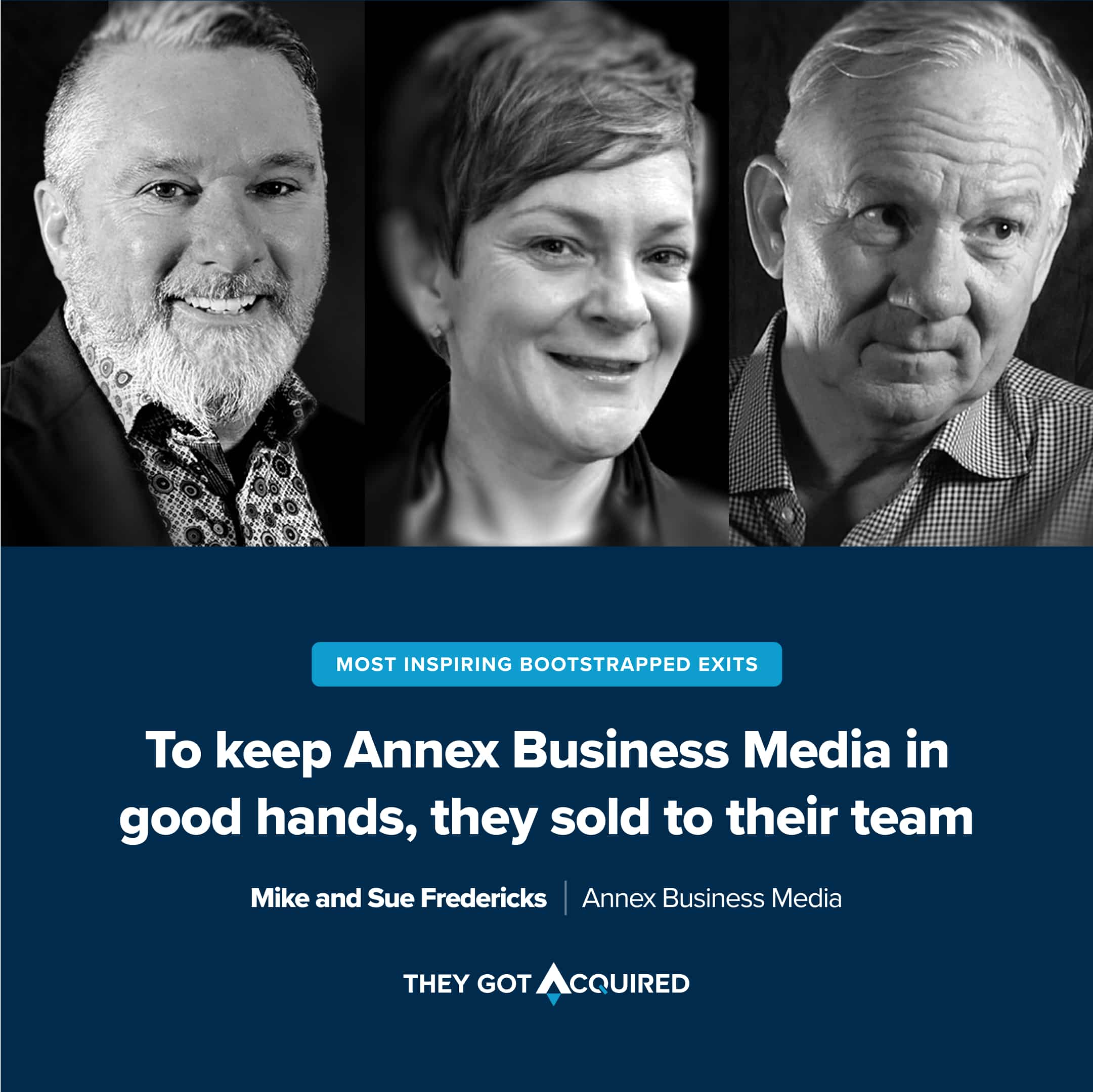
📸 Snapshot:
- Annex Business Media (content)
- Founded in 1997; sold in 2024
- Price: More than $25 million
Why we’re inspired: Mike and Sue Fredericks — and later Scott Jamieson — grew Annex Business Media from a small collection of local newspapers and industry trade magazines to Canada’s largest B2B media company with over 60 brands.
Well over a decade after launch, the Fredricks were no longer involved in the business operations, and they began considering a sale. They were approached by a private equity firm, but they wanted to be sure the buyer would run the business properly and continue its legacy.
In March 2024, they announced Annex would become an employee-owned business, selling for more than $25 million — 6x EBITDA. Although the transaction wasn’t simple, it was worth it.
“Offering the opportunity to ‘own’ Annex’s next phase to the people who helped to build our success is our way of paying it forward,” Sue said in the announcement.
Keep reading: Determined to keep the company in good hands, this B2B media business sold to its management and employees
9. After a slow start, Praveen Ghanta and Raj Udeshi sold for 16x revenue
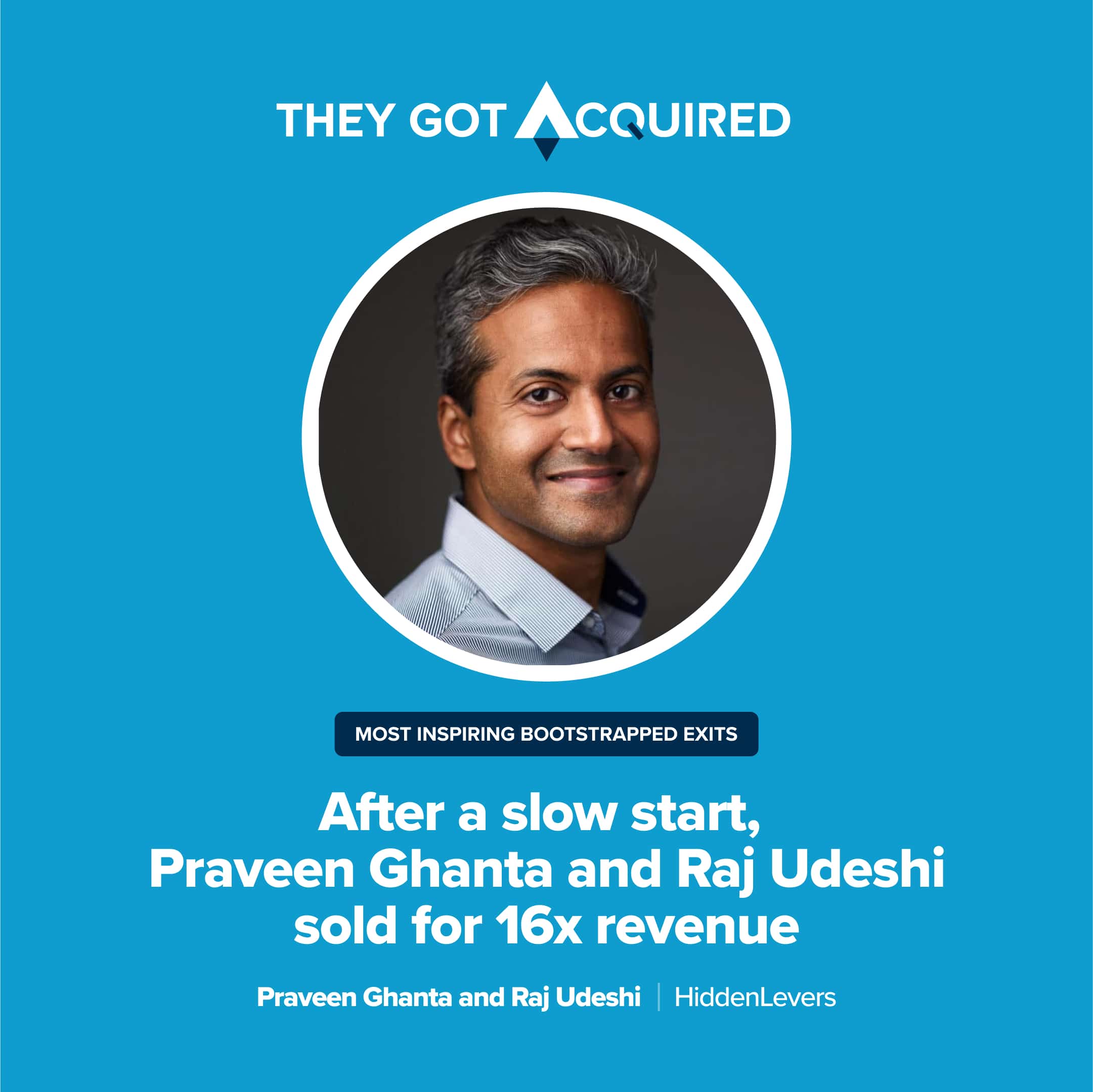
📸 Snapshot:
- HiddenLevers (SaaS)
- Founded in 2010; sold in 2021
- Price: Low 9 figures
Why we’re inspired: Praveen Ghanta, who’d worked on Wall Street for years, was interested in exploring market correlations. For example, which energy stocks are most correlated with oil prices? This information wasn’t available to the public — only hedge funds — so he built HiddenLevers.
But it took founders Ghanta and Raj Udeshi 18 months to find “any semblance of a product market fit,” Ghanta said. “We had no idea who would actually buy this product.”
The stock portfolio and risk management software finally found its sweet spot: financial advisors. Remaining bootstrapped, the software had around 450 advisory firm customers, with about 3,000 financial advisors using around a decade after launch.
Around fall 2020, the co-founders decided to sell. They agreed on a number and stood firm, ultimately got low 9 figures — a 16x revenue.
Ghanta went on to launch Fraction, which helps startups hire fractional employees — a key to HiddenLevers’ early growth.
Keep reading: This software company went from struggling to find customers to selling for 16x revenue
10. Optometrists Jenna and Travis Zigler started Eye Love to fund eye care missions

📸 Snapshot:
- Eye Love (e-commerce)
- Founded in 2015; sold in 2021
- Price: 7 figures
Why we’re inspired: Husband-and-wife optometrists Jenna and Travis Zigler started Eye Love in 2015 with the goal of making $1,000 a month. That was enough to help ease the financial burden of their annual mission trips to provide eye care in countries like Ecuador and Peru.
Eye Love sold polarized sunglasses, eyelid wash for dry eyes and more. Amazon advertising helped grow the business. By 2021, Eye Love regularly brought in $400,000 in revenue.
But it wasn’t without hurdles. The couple faced a cease-and-desist from a billion-dollar pharmaceutical company (the Ziglers prevailed), and a whole shipment of product got stuck in customs for months, temporarily cash-strapping the company.
At sale, their buyer offered 7 figures and agreed to donate affiliate earnings on Eye Love products to the Ziglers’ Eye Believe Foundation, which provides vision care around the world.
Keep reading: Eyes on the prize: How these e-commerce founders knew when the deal was right
11. Stay-at-home mom Kristi Saucerman created solution to help nonprofits fundraise better
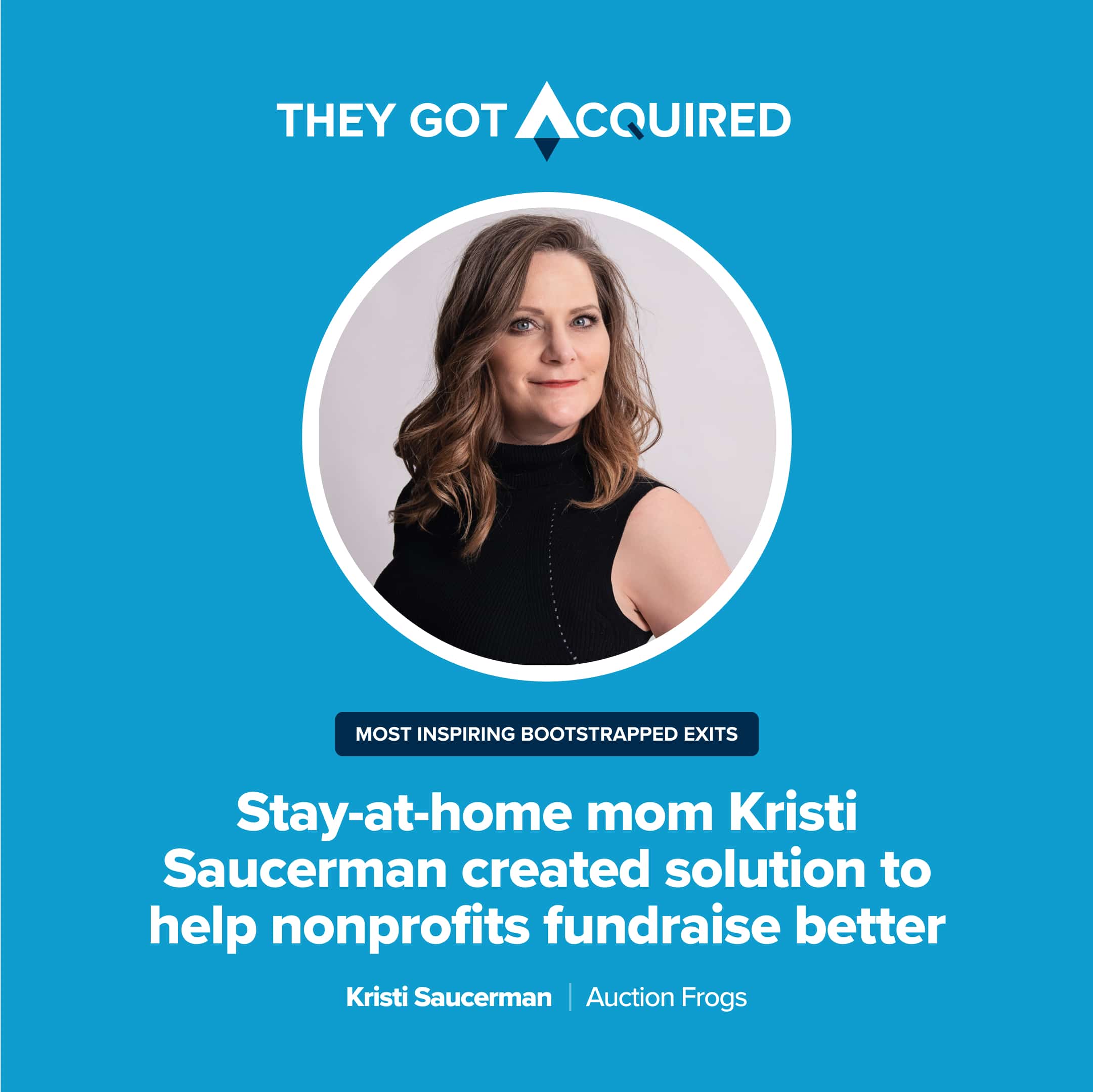
📸 Snapshot:
- Auction Frogs (SaaS)
- Founded in 2007; sold in 2022
- Price: 7 figures
Why we’re inspired: Idaho-based Kristi Saucerman launched Auction Frogs in 2007 after years of volunteering for her daughters’ charter school auctions. She worked with a software programmer to design an online automated system for silent auctions, and soon, she was getting calls from schools and churches — even someone in Florida.
For the first two years, Saucerman worked solo to grow Auction Frogs while also being a stay-at-home mom. She often worked from 10 p.m. to 2 a.m. She grew the team to 9 employees and, by 2022, reached $1 million in annual revenue.
When Lumaverse Technologies reached out about buying Auction Frogs, Saucerman immediately saw the fit and was eager for her company to grow with more resources. After the 7-figure acquisition, Saucerman stayed on as CEO.
Keep reading: Stay-at-home mom turns school auction frustration into a SaaS with $1M in revenue
12. Mother-daughter duo balanced family and success while growing an RV community

📸 Snapshot:
- Boondockers Welcome (community)
- Founded in 2012; sold in 2021
- Price: 7 figures
Why we’re inspired: Marianne Edwards and Anna Maste’s success was a direct result of prioritizing their family. In 2012, the mother-daughter duo launched Boondockers Welcome, a community for RVers to connect with property hosts.
Maste combined her coding know-how with her mom’s RV knowledge and network. She initially worked just seven hours per week, while Edwards watched Maste’s two kids.
When COVID hit and RVing surged, Boondockers Welcome attracted a mid-7-figure offer from a competitor. The sale allowed Edwards to comfortably retire and Maste to move on to a new project.
“I certainly don’t think that women can have it all,” Maste said. “I think the myth of having it all is damaging and drives many of us insane. But I think that I came as close as I could while keeping my sanity by being able to be there for my family, be there for my kids and build something that I was proud of.”
Keep reading: How a 7-hour workweek led to Anna Maste’s 7-figure sale
13. These professors went above and beyond for their students — they built a SaaS platform
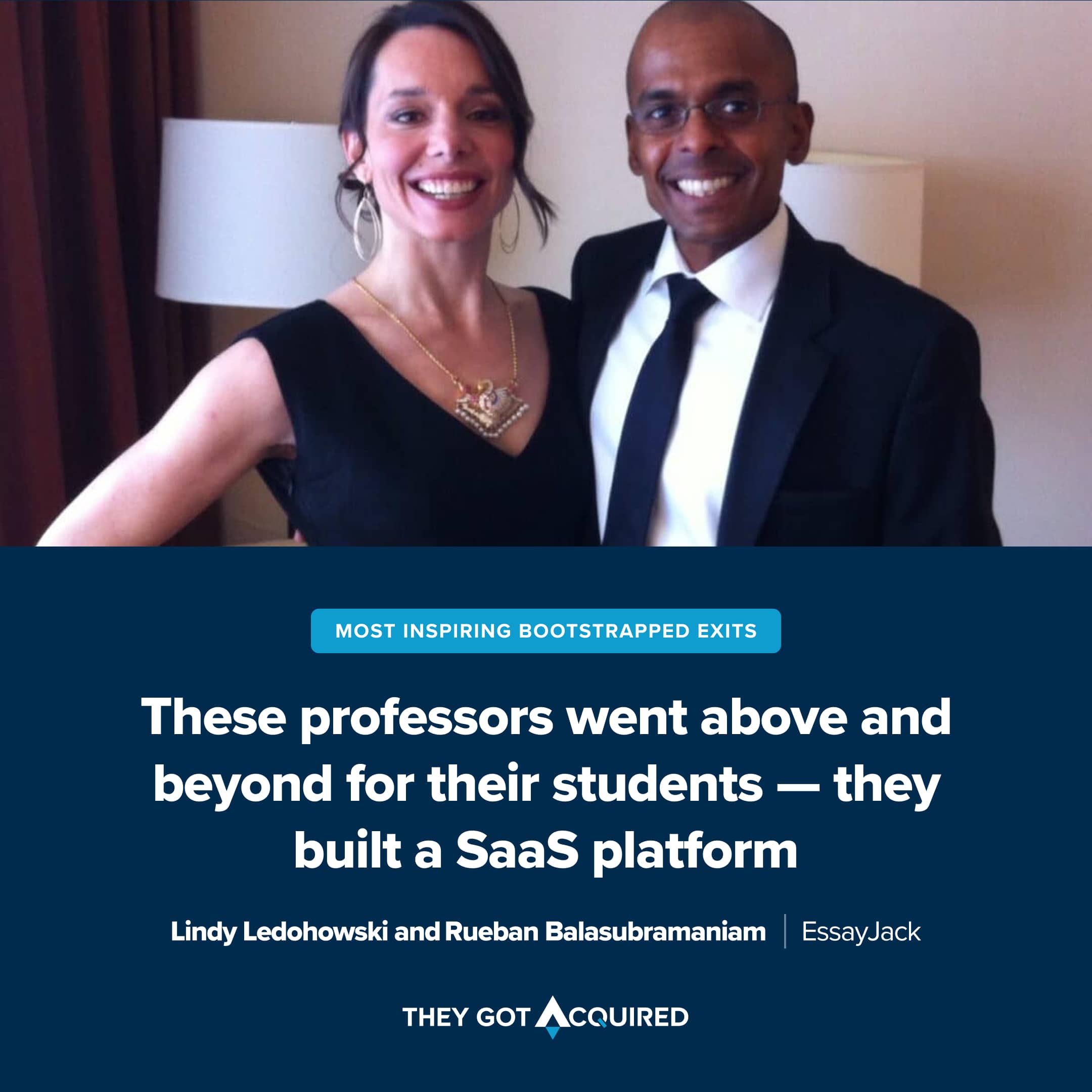
📸 Snapshot:
- EssayJack (SaaS)
- Founded in 2015; sold in 2021
- Price: Not disclosed
Why we’re inspired: Drs. Lindy Ledohowski and Rueban Balasubramaniam founded EssayJack in 2015 after seeing their students struggle with scholarly writing. The SaaS platform helped students in writing-intensive courses by providing templates, prompts and more.
To build the app, the husband-and-wife professors hired a software development firm, which offered Ledohowski an informal “apprenticeship.” “I learned a whole heck of a lot about software development,” she said. “So while not a techie by training, I’m definitely a techie by trade at this point.”
EssayJack helped more than 30,000 students with book reports, speeches, scholarly essays and more. Six years in, they received an offer from a strategic buyer, ed tech firm Wize.
Keep reading: Two professors built a SaaS that helped 30,000 students tackle academic writing
14. Dog-lover Adam Greenbaum resolved to help veterinarians build better websites

📸 Snapshot:
- WhiskerCloud (services)
- Founded in 2016; sold in 2022
- Price: Low 8 figures
Adam Greenbaum had years of experience building websites after launching a successful Boston terrier rescue site.
So in 2015, when he Googled the best local veterinary hospital for his two rescue Boston terriers and found a slew of broken links, Greenbaum began working on a solution. He spent 10 months building WhiskerCloud, an agency that built, hosted and managed veterinary websites.
By 2022, the WhiskerCloud team had grown to 22 employees who worked with 2,000 veterinary customers worldwide.
Greenbaum received multiple emails from venture capitalists each day. But he’d heard his friend and co-founder of PetDesk wanted to roll up several brands in the space to create Petvisor, a suite of technologies for pet care providers. It was a natural fit, Greenbaum said, and he agreed to a low 8-figure exit.
Keep reading: How this website agency landed 2,000 veterinarian clients and sold for 3x revenue
15. Fergus Kibble leaned into doing good when times got tough
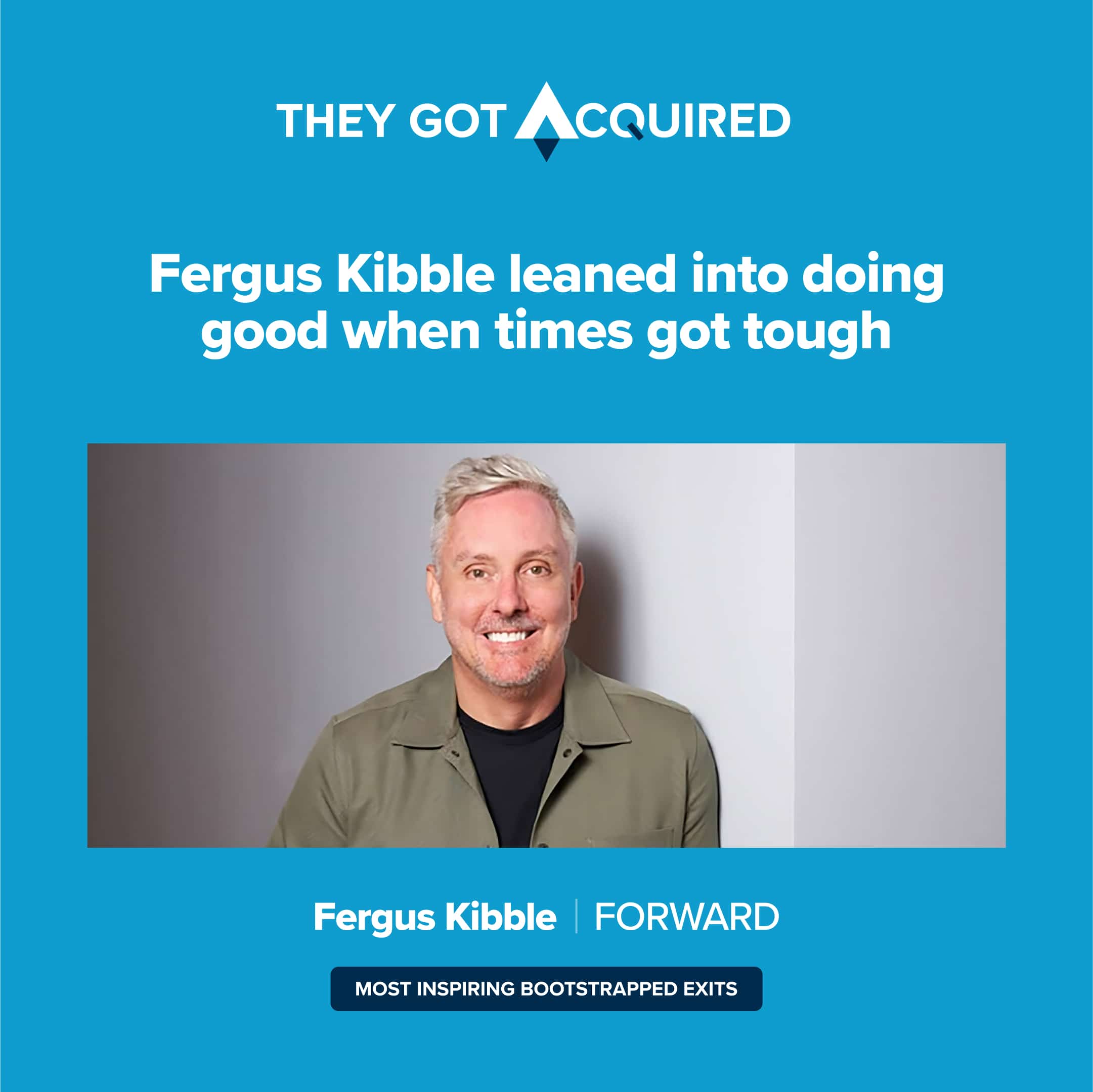
📸 Snapshot:
- FORWARD (agency)
- Founded in 2012; sold in 2023
- Price: 7 figures
Why we’re inspired: Fergus Kibble described COVID as a “near-death experience” for his PR and marketing agency FORWARD. But rather than downsizing, he pivoted FORWARD to virtual events, doubled down on influencer marketing — and pursued B Corp certification.
Becoming a B Corp in Australia requires meeting “high standards of social and environmental performance, accountability and transparency.” During the certification process, FORWARD improved its employee mental health support, enhanced its flexible working benefits, increased community giving and volunteering programs, and more.
With these changes, FORWARD ended up growing through 2020 and 2021 — and attracted a 7-figure offer.
Keep reading: Faced with a downtown, here’s what this marketing agency owner did to boost business again
16. Sent home due to COVID, college students Michael Sikand and Simran Sandhu built an agency

📸 Snapshot:
- Our Future (agency)
- Founded in 2020; sold in 2022
- Price: Not disclosed
Why we’re inspired: When Michael Sikand, a student at the University of Michigan, was sent home in April 2020 due to COVID, he started a podcast. Working alongside fellow student Simran Sandhu, the podcast evolved into Our Future, a digital media startup that produced short-form business news video content.
As TikTok began blowing up, so did Our Future. In just 18 months, it amassed over 1 billion views, averaging 30 million views per month. They worked with advertisers including Warby Parker, Shopify and HubSpot.
When the co-founders began looking for funding, Sikland connected with The Morning Brew founders, University of Michigan graduates. But CEO Austin Rief didn’t want to invest in a media company — he wanted to buy it. The Morning Brew acquired Our Future in December 2022, the same year Sikand and Sandhu graduated.
Keep reading: How two recent graduates sold their short-form video agency to Morning Brew
17. Hope Lawrence juggled being a mom while growing a granola business

📸 Snapshot:
- Hudson Henry Baking Co. (product)
- Founded in 2012; sold in 2022
- Price: Low 7 figures
Why we’re inspired: Hope Lawrence always dreamed of starting a bakery. When her family moved into a former bed and breakfast, she began baking granola in the basement’s commercial kitchen.
After being featured on the “TODAY” show, sales took off. Hudson Henry Baking Co. (named after her sons) landed in hundreds of stores nationwide. But Lawrence, who stayed up until 1 a.m. to bag granola, experienced a lot of “mom guilt.” She took a consultant’s advice and hired part-time employees, including stay-at-home moms, retirees and college students.
When Lawrence turned 50, she was ready for a change. She found her buyer through a broker and in April 2022, Hudson Henry Baking Co. sold for 7 figures — 5x to 6x net annual income.
She has since started Small Batch Empire where she helps makers launch and grow small-batch food companies. She is also building Kamille.io, a wholesale revenue assistant for makers.
Keep reading: How this family baked granola downstairs, hit $1 million revenue and landed a deal
